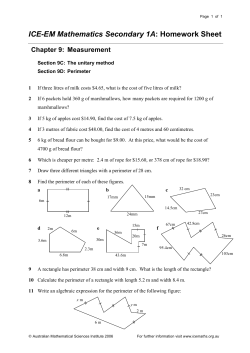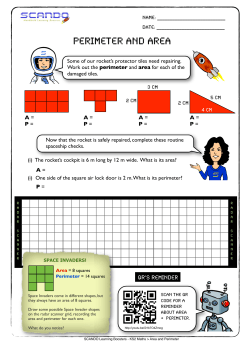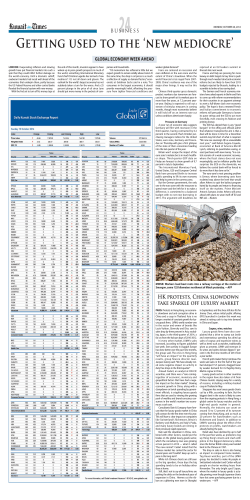
Lecture Notes - Gosunyani.com
Programming with the Problem Analysis–Coding–Execution Cycle • Programming is a process of problem solving. Different people use different techniques to solve problems. • Some techniques are nicely outlined and easy to follow. • They not only solve the problem but also give insight into how the solution was reached. • These problem-solving techniques can be easily modified if the domain of the problem changes. Algorithm • To be a good problem solver and a good programmer, you must follow good problemsolving techniques. • One common problem-solving technique includes analyzing a problem, outlining the problem requirements, and designing steps,, to solve the problem. Algorithm: A step-by-step problem-solving process in which a solution is arrived at in a finite amount of time. Algorithm cont. In a programming environment, the problemsolving process requires the following three steps: Analyze the problem, outline the problem and its solution requirements, and design an algorithm to solve the problem. Implement the algorithm in a programming language, such as C++, and verify that the algorithm works. Maintain the program by using and modifying it if the problem domain changes. summarizes this three-step programming process. To develop a program to solve a problem, you start by analyzing the problem. You then design the algorithm; write the program instructions in a high-level language, or code the program; and enter the program into a computer system. Analyzing the problem is the first and most important step. This step requires you to do the following: Thoroughly understand the problem. Understand the problem requirements. Requirements can include whether the program requires interaction with the user, whether it manipulates data, whether it produces output, and what the output looks like. If the program manipulates data, the programmer must know what the data is and how it is represented. That is, you need to look at sample data. If the program produces output, you should know how the results should be generated and formatted. If the problem is complex, divide the problem into sub problems and repeat Steps 1 and 2. That is, for complex problems, you need to analyze each sub problem and understand each sub problem’s requirements. After you carefully analyze the problem, the next step is to design an algorithm to solve the problem. If you broke the problem into sub problems, you need to design an algorithm for each sub problem. Once you design an algorithm, you need to check it for correctness. Flow chart Using flow chart to solve problem The Basics of a C++ Program A C++ program is a collection of one or more subprograms, called functions. A subprogram or a function is a collection of statements, and when it is activated, or executed, it accomplishes something. Some functions, called predefined or standard functions, are already written and are provided as part of the system. But to accomplish most tasks, programmers must learn to write their own functions. The syntax rules tell you which statements (instructions) are legal, or accepted by the programming language, and which are not. semantic rules, which determine the meaning of the instructions. The programming language’s rules, symbols, and special words enable you to write programs to solve problems. The syntax rules determine which instructions are valid. Programming language: A set of rules, symbols, and special words. C++ Keywords (partial list) • • • • • • • • • • bool catch delete false friend inline namespace new operator private • • • • • • • • • • protected public template this throw true try using virtual wchar_t 12 Data Types Data type: A set of values together with a set of operations. C++ data types fall into the following three categories; Simple data type Pointers Simple Data Types • The simple data type is the fundamental data type in C++ because it becomes a building block for the structured data type, There are three categories of simple data: Integral, which is a data type that deals with integers, or numbers without a decimal part Floating-point, which is a data type that deals with decimal numbers Enumeration type, which is a user-defined data type EXAMPLE 1 Design an algorithm to find the perimeter and area of a rectangle. To find the perimeter and area of a rectangle, you need to know the rectangle’s length and width. The perimeter and area of the rectangle are then given by the following formulas: Perimeter = 2 * (length + width) Area = length * width Example 1 cont. The algorithm to find the perimeter and area of the rectangle is: 1. Get the length of the rectangle. 2. Get the width of the rectangle. 3. Find the perimeter using the following equation: perimeter = 2 (length + width) 4. Find the area using the following equation: area = length width Example 2 Design an algorithm that calculates the sales tax and the price of an item sold in a particular state. The sales tax is calculated as follows: • The state’s portion of the sales tax is 4% and the city’s portion of the sales tax is 1.5%. If the item is a luxury item, such as a car over $50,000, then there is a 10% luxury tax. • To calculate the price of the item, we need to calculate the state’s portion of the sales tax, the city’s portion of the sales tax, and, if it is a luxury item, the luxury tax. Lets salePrice be selling price of the item, stateSalesTax be the state’s sales tax, citySalesTax be the city’s sales tax, luxuryTax be the luxury tax, salesTax be the total sales tax, amountDue the final price of the item. To calculate the sales tax, we must know the selling price of the item and whether the item is a luxury item. The stateSalesTax and citySalesTax can be calculated using the following formulas: • stateSalesTax = salePrice * 0.04 • citySalesTax = salePrice * 0.015 Next, you can determine luxuryTax as follows: if (item is a luxury item) luxuryTax = salePrice 0.1 otherwise luxuryTax = 0 Next, you can determine salesTax as follows: salesTax = stateSalesTax + citySalesTax + luxuryTax Finally, you can calculate amountDue as follows: amountDue = salePrice + salesTax The algorithm to determine salesTax and amountDue is, therefore: 1. Get the selling price of the item. 2. Determine whether the item is a luxury item. 3. Find the state’s portion of the sales tax using the formula: stateSalesTax = salePrice 0.04 1. Find the city’s portion of the sales tax using the formula: citySalesTax = salePrice 0.015 5. Find the luxury tax using the following formulas: if (item is a luxury item) luxuryTax = salePrice 0.1 otherwise luxuryTax = 0 6. Find salesTax using the formula: salesTax = stateSalesTax + citySalesTax + luxuryTax 7. Find amountDue using the formula: amountDue = salePrice + salesTax Assignment Design an algorithm that calculates the monthly paycheck of a salesperson at a local department store. • Every salesperson has a base salary. The salesperson also receives a bonus at the end of each month, based on the following criteria: If the salesperson has been with the store for five years or less, the bonus is $10 for each year that he or she has worked there. If the salesperson has been with the store for more than five years, the bonus is $20 for each year that he or she has worked there. The salesperson can earn an additional bonus as follows: If the total sales made by the salesperson for the month are more than $5,000 but less than $10,000, he or she receives a 3% commission on the sale. If the total sales made by the salesperson for the month are at least $10,000, he or she receives a 6% commission on the sale.
© Copyright 2025









